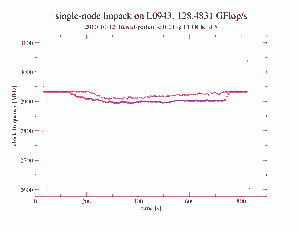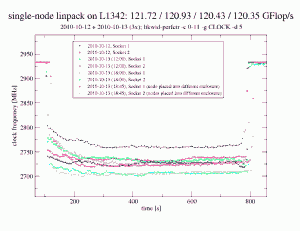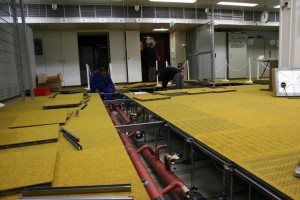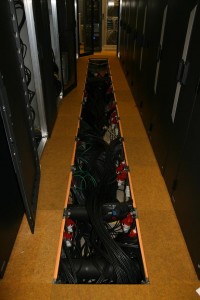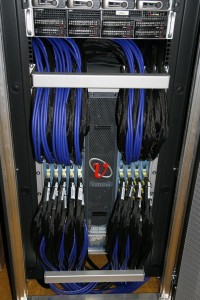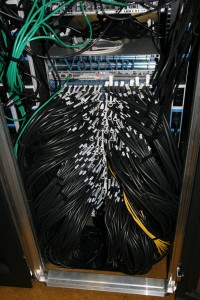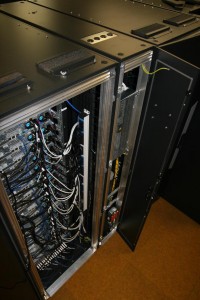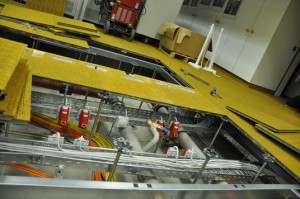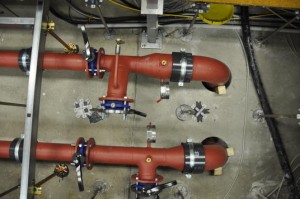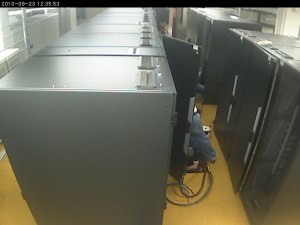The environment variable CUDA_VISIBLE_DEVICES lists which devices are visible as a comma-separated string. E.g. export CUDA_VISIBLE_DEVICES=0,3 will select an C2070 and C2050 on the tg010 compute node of TinyGPU.
Content
Getting started on LiMa
Early friendly user access was enabled on LiMa end of October 2010. The system and user environment is still in progress. Here are a few notes (“FAQs”) describing specialties of the present configuration and major changes during the early days of operation …
What are the hardware specifications
- 2 login nodes (lima1/lima2)
- two-sockets with Intel Westmere X5650 (2.66 GHz) processors; 12 physical cores, 24 logical cores per node
- 48 GB DDR3 memory (plus 48 GB swap)
- 500 GB in /scratch on a local harddisk
- 500 compute nodes (Lrrnn)
- two-sockets with Intel Westmere X5650 (2.66 GHz) processors; 12 physical cores, 24 logical cores per node
- 24 GB DDR3 memory (NO swap) – roughly 22 GB available for user applications as the rest is used for the OS in the diskless operation
- NO local harddisk
- QDR Infiniband
- parallel filesystem (/lxfs)
- ca. 100 TB capacity
- up to 3 GB/s of aggregated bandwidth
- OS: CentOS 5.5
- batch system: torque/maui (as also on the other RRZE systems)
Where / how should I login?
SSH to lima.rrze.uni-erlangen.de and you will end up on one of the two login nodes. As usual, these login nodes are only assessable from within the University network. A VPN-split-tunnel might not be enough to be on the University network as some of the Universities’ priviate IP addresses as e.g. used by the HPC systems are not added to the default list of networks routed through the split tunnel. In case of problems, log into cshpc.rrze.uni-erlangen.de first.
I have some specific problems on LiMa
First of all check if the issue is already described in the online version of the article. If not, contact hpc-support@rrze with as much information as possible.
I’d like to contribute some documentation
Please add a comment to this article (Log into the Blog system using your IDM account/password which is not not necessarily identical to your HPC account. All FAU students and staff should have an IDM account) or send an email to hpc@rrze.
There are almost no modules visible (Update 2010-11-25)
For now, please execute source /apps/rrze/etc/user-rrze-modules.csh (for csh/tcsh) or . /apps/rrze/etc/use-rrze-modules.sh (for bash) to initialize the RRZE environment. This command will also set some environment variables like WOODYHOME or FASTTMP.
Once the system goes into regular operation, this step will no longer be required.
2010-11-25: The login and compute nodes nodes now already have the full user environment by default.
How should I submit my jobs
Always use ppn=24 when requesting nodes as each node has 2×6 physical cores but 24 logical cores due to SMT.
$FASTTMP is empty – where are my files from the parallel filesystem on Woody?
The parallel filesystem on Woody and LiMa are different and not shared. However, $FASTTMP is used on both systems to point to the local parallel filesystem.
How can I detect in my login scripts whether I’m on Woody or on LiMa
There are many different ways to detect this; one option is to test for /wsfs/$GROUP/$USER (Woody or some of the Transtec nodes) and /lxfs/$GROUP/$USER (LiMa).
In the future, we might provide an environment variable telling you the cluster (Transtec, Woody, TinyXY, LiMa).
Should I recompile my binaries for LiMa?
Many old binaries will run on LiMa, too. However, we recommend to recompile on the LiMa frontends as many of the tools and libraries are newer on LiMa in their default version as on Woody.
How do I start MPI jobs on LiMa? (Update: 2010-11-03; 2010-12-18)
First of all, correct placement (“pinning”) of processes is much more important on LiMa (and also TinyXY) than on Woody (or the Transtec cluster) as all modern nodes as ccNUMA and you only achieve best performance if data access is into the local memory. Attend an HPC course if you do not know what ccNUMA is!
Do not use theThere is nompirunin the default $PATH if no MPI module is loaded. This hopefully will change when regular user operation starts.mpirunin the default $PATH (unless you have the openmpi moule loadeed).- For Intel-MPI to use an start mechanism more or less compatible to the other RRZE clusters use
/apps/rrze/bin/mpirun_rrze-intelmpd -intelmpd -pin 0_1_2_3_4_5_6_7_8_9_10_11 .... In this way, you can explicitly pin all you processes as on the other RRZE clusters. However, this algorithm does not scale up to the highest process counts. An other option (currently only available on LiMa) is to use one of the official mechanisms of Intel MPI (assuming use usebashfor your job script andintempi/4.0.0.028-[intel|gnu]is loaded):
export PPN=12
gen-hostlist.sh $PPN
mpiexec.hydra -print-rank-map -f nodes.$PBS_JOBID [-genv I_MPI_PIN] -n XX ./a.out
Attention: pinning does not work properly in all circumstances for this start method. See chapter 3.2 of/apps/intel/mpi/4.0.0.028/doc/Reference_Manual.pdffor more details onI_MPI_PINand friends.- An other option (currently only available on LiMa) is to use one of the official mechanisms of Intel MPI (assuming use use
bashfor your job script andintempi/4.0.1.007-[intel|gnu]is loaded):
export PPN=12
export NODES=`uniq $PBS_NODEFILE | wc -l`
export I_MPI_PIN=enable
mpiexec.hydra -rmk pbs -ppn $PPN -n $(( $PPN * $NODES )) -print-rank-map ./a.out
Attention: pinning does not work properly in all circumstances for this start method. See chapter 3.2 of/apps/intel/mpi/4.0.1.0007/doc/Reference_Manual.pdffor more details onI_MPI_PINand friends. - There are of course many more possibilities to start MPI programs …
Hints for Open MPI (2010-12-18)
Starting from today, the openmpi modules on LiMa set OMPI_MCA_orte_tmpdir_base=/dev/shm as $TEMPDIR points to a directory on the LXFS parallel filesystem and, thus, Open MPI might/would show bad performance for shared-memory communication.
Pinning can be achieved for Open MPI using mpirun -npernode $ppn -bind-to-core -bycore -n $(( $ppn * $nodes )) ./a.out
PBS output files already visible while the job is running (Update: 2010-11-04; 2010-11-25)
As the compute nodes run without any local harddisk (yes, there is only RAM and nothing else locally on the compute nodes to store things), we are experimenting with a special PBS/MOM setting which writes the PBS output files (*.[o|e]$PBS_JOBID or what you specified using PBS -[o|e]) directly to the final destination. Please do not rename/delete these files while the job is running and do not be surprised that you see the files while the job is running.
The special settings are: $spool_as_final_name and $nospool_dir_list in the mom_config. I’m not sure if we will keep these settings in the final configuration. They save space in the RAM of the compute node but there are also administrative disadvantages …
2010-11-25: do not use #PBS -o filename or #PBS -e filename as PBS may cause trouble if the file already exists. Without the -o/-e PBS will generate files based on the script name or #PBS -N name and append .[o|e]$PBS_JOBID.
[polls id=”1″]
You have to login into the Blog system using your IDM account to be able to vote!
Where should I store intermediate files?
The best is to avoid intermediate files or small but frequent file IO. There is no local harddisk. /tmp is part of the main memory! Please consult hpc-support@rrze to assist analyzing your IO requirements.
Large files which are read/written in large blocks should be put to $FASTTMP. Remember: as on Woody there is no backup on $FASTTMP. There are currently also no quotas – but we will probably implement high-water-mark deletion as on Woody.
Small files probably should be put on $WOODYHOME.
File you want to keep for long time should be moved to /home/vault/$GROUP/$USER. The data access rate to /home/vault currently is limited on LiMa. Please use with care.
/tmp, $TMPDIR and $SCRATCH (2010-11-20 / update 2010-11-25)
As the nodes are diskless, /tmpis part of a ramdisk and does not provide much temporary scratch space. As of 2010-11-20, a new environment variable $SCRATCH is defined by use-rrze-module.csh/sh which points to a node-specific directory on the parallel filesystem. The PBS configuration is not yet adapted, i.e. $TMPDIR within a job still points to a job specific directory within the tiny /tmp directory.
2010-11-25: /scratch ($SCATCH) is a node-specific directory on LXFS. (At least once the compute nodes are rebooted.)
2010-11-25: $TMPDIR now points to a job-private directory within $SCRATCH, i.e. is on LXFS; all data in $TMPDIR will be deleted at the end of the job. (At least once the compute nodes are rebooted.)
/tmp is still small and part of the node’s RAM.
mpirun from my commercial code aborts during startup with connection refused
On the LiMa nodes there are currently true Make sure that the MPI implementation does not try to start remote processes using rsh binaries installed.rsh as there are no RSH daemons running for security reasons as RSH is not installed and there are also no symlinks from rsh to ssh as on the other RRZE systems. Enforce the usage of SSH. The rsh binaries probably will be uninstalled before regular user operation and replaced by links to the ssh binary (as on most of the other RRZE clusters).
Update 2010-11-05: rsh and rsh-server have been uninstalled. There are however no links from rsh to ssh.
There is obviously some software installed in /opt (e.g. /opt/intel/ and /opt/openmpi)
Do not use any software from /opt. All these installations will be removed before regular user operation starts. RRZE-rpvoded software is in /apps and in almost all cases accessible through modules. /apps is not (and will not be) shared between LiMa and Woody.
My application tells that it could not allocate the required memory (Update 2010-11-12)
memory overcommit is limited on LiMa. Thus, not only the resident (i.e. actually) used memory is relevant but also the virtual (i.e. total) memory which sometimes is significantly higher. Complain to the application developer. There is currently no real work around on LiMa.
As we are still experimenting with the optimal values of the overcommit limitation, there might be temporal chances (including times when overcommitment is not limited).
Memory issues might also come from an inappropriate stacksize line in ~/.cshrc (or ~/.bashrc). Try to remove any stacksize line in your login scripts.
IO performance to $FASTTMP (/lxfs/GROUP/USER) seems to be very low (2010-11-03/2010-11-12)
The default striping is not optional yet; it uses only one OST, thus, performance is limited by roughly 100 MB/s. Use 2010-11-25: RRZE will activate reasonable file striping, thus, it should not be necessary for normal users to set striping manually. Modified striping only affects newly created files/subdirectories.lfs setstripe --count -1 --size 128m DIRECTORY to manually activate striping over 16 OSTs.
The stripe size (--size argument) should match your applications’ IO patterns.
PBS commands do not work – but they used to work / Jobs are not started (2010-11-03)
The PBS server currently has a severe bug: If a jobs requests too much memory and thus crashed the master node of the job, the PBS server stalls for quite long time (several hours) and does not respond at all to any requests (although its running on a different server). This may lead to hanging user commands or error messages like pbs_iff: cannot read reply from pbs_server. No permission or cannot connect to server ladm1 or Unauthorized Request. And of course, while the PBS server process hangs, no new jobs are started.
If you are interested in the technical details: look at the bugzilla entry at
http://www.clusterresources.com/bugzilla/show_bug.cgi?id=85
mpiexec.hydra and LD_LIBRARY_PATH (2010-11-08)
It currently looks like mpiexec.hydra from Intel-MPI 4.0.0.x does not respect LD_LIBRARY_PATH settings. Further investigations are currently carried out. Right now it looks like an issue with the NEC login scripts on the compute nodes which overwrite the LD_LIBRARY_PATH setting.
Suggested workaround for now: mpiexec.hydra ... env LD_LIBRARY_PATH=$LD_LIBRARY_PATH ./a.out.
Other MPI start mechanisms might be affected, too.
2010-11-25: it’s not clear if the work around is still required as mpi-selector/Oscar-modules/env-switcher have been uninstalled in the mean time.
MPI-IO and Intel MPI 4.0.1.007 (2010-12-09)
Probably not only a LiMa issue but also relevant on LiMa. MPI-IO to $FASTTMP with Intel MPI 4.0.1.007 (4.0up1) fails with “File locking failed” unless the following environment variables are set: I_MPI_EXTRA_FILESYSTEM=on I_MPI_EXTRA_FILESYSTEM_LIST=lustre. Intel MPI up to 4.0.0.028 worked fine without and with these variables set.
I_MPI_EXTRA_FILESYSTEM=on I_MPI_EXTRA_FILESYSTEM_LIST=lustre get set by the intelmpi/4.0.1.007-* module (since 2011-02-02)
STAR-CCM+ (2010-11-12)
Here is a (partially tested) sample job script:
[bash]
#!/bin/bash -l
#PBS -l nodes=4:ppn=24
#PBS -l walltime=00:25:00
#PBS -N simXYZ
#PBS -j eo
# star-ccm+ arguments
CCMARGS=”-load simxyz.sim”
# specify the time you want to have to save results, etc.
TIME4SAVE=1200
# number of cores to use per node
PPN=12
# some MPI options; explicit pinning – must match the PPN line
MPIRUN_OPTIONS=”-cpu_bind=v,map_cpu:0,1,2,3,4,5,6,7,8,9,10,11″
### normally, no changes should be required below ###
module add star-ccm+/5.06.007
echo
# count the number of nodes
NODES=`uniq ${PBS_NODEFILE} | wc -l`
# calculate the number of cores actually used
CORES=$(( ${NODES} * ${PPN} ))
# check if enough licenses should be available
/apps/rrze/bin/check_lic.sh -c ${CDLMD_LICENSE_FILE} hpcdomains $(($CORES -1)) ccmpsuite 1
. /apps/rrze/bin/check_autorequeue.sh
# change to working directory
cd ${PBS_O_WORKDIR}
# generate new node file
for node in `uniq ${PBS_NODEFILE}`; do
echo “${node}:${PPN}”
done > pbs_nodefile.${PBS_JOBID}
# some exit/error traps for cleanup
trap ‘echo; echo “*** Signal TERM received: `date`”; echo; rm pbs_nodefile.${PBS_JOBID}; exit’ TERM
trap ‘echo; echo “*** Signal KILL received: `date`”; echo; rm pbs_nodefile.${PBS_JOBID}; exit’ KILL
# automatically detect how much time this batch job requested and adjust the
# sleep accordingly
export TIME4SAVE
( sleep ` qstat -f ${PBS_JOBID} | awk -v t=${TIME4SAVE} \
‘{if ( $0 ~ /Resource_List.walltime/ ) \
{ split($3,duration,”:”); \
print duration[1]*3600+duration[2]*60+duration[3]-t }}’ ` && \
touch ABORT ) >& /dev/null &
SLEEP_ID=$!
# start STAR-CCM+
starccm+ -batch -rsh ssh -mppflags “$MPIRUN_OPTIONS” -np ${CORES} -machinefile pbs_nodefile.${PBS_JOBID} ${CCMARGS}
# final clean up
rm pbs_nodefile.${PBS_JOBID}
pkill -P ${SLEEP_ID}
[/bash]
Solved issues
- cmake – (2010-10-26) – rebuilt from sources; should work now without dirty LD_LIBRARY_PATH settings
- svn – (2010-10-26) – installed CentOS rpm on the login nodes; the version unfortunately is a little bit old (1.4.2); however, there is no real chance to get a newer on on LiMa. Goto cshpc to have at least 1.5.0
- qsub from compute nodes – (2010-10-26) – should work now; added
allow_node_submit=trueto PBS server - vim – (2010-10-27) – installed CentOS rpm of vim-enhanced on the login nodes
- autologout – (2010-10-27) – will be disabled for CSH once
/apps/rrze/etc/use-rrze-modules.cshis sourced - xmgrace, gnuplot, (xauth) – (2010-11-02) – installed on the login nodes; version from CentOS rpm
- clock skew on /lxfs ($FASTTEMP) is now hopefully really fixed (2010-11-04)
rshandrsh-serverhave been uninstalled from compute/login/admin nodes (2010-11-05)- several usability improvements added to
use-rrze-modules.csh/sh(2010-11-19)
LiMa, LIKWID und der Turbo Boost
Intel hat mit den Nehalem-Prozessoren (Xeon X55xx bzw. Core i7) den Turbo Boost-Modus eingeführt, bei dem stark vereinfacht gesagt, einzelne Prozessorkerne automatisch höher takten können, wenn nur Teile des gesamten Prozessorchips genutzt werden und somit “Luft” bei Stromverbrauch, Spannung und Temperatur ist. Im LiMa-Cluster sind Intel Westmere Prozessoren mit 2,66 GHz (Intel Xeon X5650) verbaut. Diese Prozessoren erlaubt prinzipiell (bis zu) zwei Turbo Boost-Stufen (+2×133 MHz), auch dann wenn alle Kerne benutzt sind, und bis zu drei Turbo Boost-Stufen (+3×133 MHz), wenn maximal zwei der sechs Kerne eines Prozessorchips in Benutzung sind (vgl. Tabelle 2 im Intel Xeon Processor 5600 Series Specification Update vom September 2010). Das heißt unter günstigen Bedingungen laufen alle Prozessorkerne auch unter Volllast mit 2,93 GHz obwohl man eigentlich nur einen 2,66 GHz-Prozessor gekauft hat.
Dass annähernd zwei volle Turbo Boost-Stufen auch unter Vollast möglich sind, zeigt nebenstehende Grafik. Hierbei wurde mit einer Auflösung von 5 Sekunden die Taktfrequenz aller physikalischen Kerne im Knoten mittels LIKWID gemessen, während auf dem Knoten die multi-threaded LINPACK-Version aus Intel’s MKL lief. Bevor die LINPACK-Prozesse anlaufen, haben die Prozessorkerne aufgrund der ondemand-Frequenzeinstellung im Linux-Betriebssystem heruntergetaktet. Sobald “Last” generiert wird, takten die Prozessoren hoch. Wenn nach etlichen Sekunden die Prozessoren “durchgeheizt” sind, sinkt die Taktfrequenz nur leicht von 2,93 GHz auf rund 2,90 GHz. Am Ende des bzw. kurz nach dem LINPACK-Lauf takten die Prozessoren kurzfristig nochmals hoch, da zum einen die Last geringer geworden ist und somit die thermischen und elektrischen Grenzwerte für den Turbo Boost-Mode unterschritten sind, gleichzeitig der ondemand-Regler des Linux-Betriebssystems die Prozessoren aber noch nicht herunter getaktet hat. In der Grafik sind im wesentlichen nur zwei Kurven zu erkennen, obwohl es eigentlich 12 sind, da alle Kerne eines Sockels praktisch immer mit der gleichen Frequenz laufen.
Leider laufen jedoch nicht immer alle X5650-Prozessoren unter Volllast mit annähernd zwei Turbo Boost-Stufen, d.h. 2,93 GHz, wie die zweite Grafik zeigt. Hier takten die Rechenkerne über weite Teile des LINPACK-Laufs auf “nur” 2,7 GHz herunter, wodurch die gemessene Knotenleistung von rund 128,5 GFlop/s auf 120,5 GFlop/s sinkt — über 5% die man sicherlich auch in der einen oder anderen Form bei realen Anwendungen und nur nicht nur beim synthetischen LINPACK sieht.
Über die Ursachen der geringeren Übertaktung des zweiten Knotens kann derzeit nur spekuliert werden. Die Wärmeleitpaste zwischen den Prozessoren und den Kühlkörpern ist es jedenfalls nachweislich nicht. Ebenso ist es nicht das Netzteil oder die Position im Rack, da ein Umzug des Rechenknoten in ein anderes Enclosure in einem anderen Rack keine Besserung brachten. BIOS-Version, CMOS-Einstellung und CPU-Stepping sollten hoffentlich bei allen Knoten auch gleich sein. Dass zwei Prozessoren aus Hunderten eine Macke haben, mag ja durchaus sein, aber wie wahrscheinlich ist es, dass genau diese zwei Prozessoren dann auch noch im gleichen Rechner verbaut werden … Als wahrscheinlichste Ursache würde ich daher im Moment “Toleranzen” bei den Mainboards vermuten, die sich negativ auswirken. Aber Details wird NEC sicherlich im eigenen und unseren Interesse noch herausfinden …
Performance-Messtools wie LIKWID zahlen sich auf jeden Fall auch für die Abnahme von HPC-Clustern aus.
Hier nochmal sinngemäß die Befehle, die ich zur Messung verwendet habe: (LIKWID 2.0 ist dabei aufgrund des Daemon-Modus mindestens nötig und /dev/cpu/*/msr muss durch den aufrufenden User les- und schreibbar sein):
[shell]
/opt/likwid/2.0/bin/likwid-perfctr -c 0-11 -g CLOCK -d 5 | tee /tmp/clock-speed-`hostname`-`date +%Y%m%d-%H%M`.log > /dev/null &
sleep 15
env OMP_NUM_THREADS=12 taskset -c 0-11 /opt/intel/Compiler/11.1/073/mkl/benchmarks/linpack/xlinpack_xeon64 lininput_xeon64-50k
sleep 15
kill $! >& /dev/null
[/shell]
Da die Taktfrequenz eine abgeleitete Größe ist, kann es vorkommen, dass einzelne CPUs nan als Taktfrequenz liefern, wenn keine Instruktionen ausgeführt werden. Aber das ist natürlich nur dann der Fall, wenn auch kein Programm auf dem Prozessorkern läuft.
LiMa, Kühlschränke und Toster
Unser neuer HPC-Cluster hat geschlossene Racks mit Kühleinheiten dazwischen (vgl. https://blogs.fau.de/zeiser/2010/09/21/rechnerzuwachs-und-generationswechsel-bei-den-hpc-clustern-am-rrze/). Auf die Mail meines Kollegen mit der Bitte um DNS-Einträge für die Kühlschränke kam als Antwort …wenn Ihr bei den Toastern angelangt seid, nehmt ihr aber IPv6. Die Rechenknoten sind zwar so etwas ähnliches wie Toster, haben aber trotzdem IPv4-Adressen.
Aktueller LiMa-Status:
Zurück zu den ernsten Dingen: der mechanische Aufbau und die Verkabelung des Clusters sind praktisch abgeschlossen und am vergangenen Donnerstag (30.9.2010) wurden erstmals alle Knoten des neuen Clusters eingeschaltet. Es geht also voran ….
Ein paar weitere Impressionen vom Aufbau:
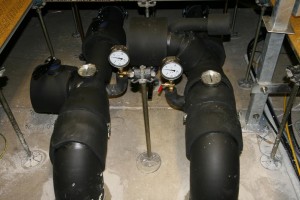
Kaltwasserrohre mit Isolierung im Doppelboden. Man beachte das Verhältnis von Wasserrohrdurchmesser und Dicke der Stützen des Doppelbodens!
Recipe for building OpenFOAM-1.7.1 with Intel Compilers and Intel MPI
Compared with other software, installing OpenFOAM is (still) a nightmare. They use their very own build system, there are tons of environment variables to set, etc. But it seems that users in academia and industry accept OpenFOAM nevertheless. For release 1.7.1, I took the time to create a little receipt (in some parts very specifically tailored to RRZE’s installation of software packages) to more or less automatically build OpenFOAM and some accompanying Third Party packages from scratch using the Intel Compilers (icc/icpc) and Intel MPI instead of Gcc and Open MPI (only Qt and Paraview are still built using gcc). The script is provided as-is without any guarantee that it works elsewhere and of course also without any support. The script assumes that the required source code packages have already been downloaded. Where necessary, the unpacked sources are patched and the compilation commands are executed. Finally, two new tar balls are created which contain the required “output” for a clean binary installation, i.e. intermediate output files (e.g. *.dep) are not included …
Compilation takes ages, but that’s not really surprising. Only extracting the tar balls with the sources amounts to 1.6 GB in almost 45k files/directories. After compilation (although neither Open MPI nor Gcc are built) the size is increased to 6.5 GB or 120k files. If all intermediate compilation files are removed, there are still about 1 GB or 30k files/directories remaining in my “clean installation” (with only the Qt/ParaView libraries/binaries in the ThirdParty tree).
RRZE users find OpenFOAM-1.7.1 as module on Woody and TinyBlue. The binaries used for Woody and TinyBlue are slightly different as both were natively compiled on SuSE SLES 10SP3 and Ubuntu 8.04, respectively. The main difference should only be in the Qt/Paraview part as SLES10 and Ubuntu 8.04 come with different Python versions. ParaView should also be compiled with MPI support.
Note (2012-06-08): to be able to compile src/finiteVolume/fields/fvPatchFields/constraint/wedge/wedgeFvPatchScalarField.C with recent versions of the Intel compiler, one has to patch this file to avoid an no instance of overloaded function “Foam:operator==” matches the argument list error message; cf. http://www.cfd-online.com/Forums/openfoam-installation/101961-compiling-2-1-0-rhel6-2-icc.html and https://github.com/OpenFOAM/OpenFOAM-2.1.x/commit/8cf1d398d16551c4931d20d9fc3e42957d0f93ca. These links are for OF-2.1.x but the fix works for OF-1.7.1 as well.
Halbzeit beim Projekt SKALB
Beim BMBF-HPC-Verbundprojekt “SKALB” (Lattice-Boltzmann-Methoden für skalierbare Multi-Physik-Anwendungen) ist inzwischen die Hälfte der Projektlaufzeit verstrichen. Wer sich über die bisherigen Projektergebnisse informieren will, findet auf der Projekt-Webseite www.skalb.de in der Rubrik Ergebnisse & Showcases neben einer Auflistung von Vorträgen und Publikationen auch die Managementzusammenfassungen der Projektzwischenberichte für die ersten drei Halbjahre.
Rechnerzuwachs und Generationswechsel bei den HPC-Clustern am RRZE
Vorarbeiten
Rechnerzuwachs klingt doch recht bescheiden, aber so sind wir eben. Dennoch ist am RRZE seit Wochen eine deutlich erhöhte Betriebsamkeit und Bautätigkeit zu beobachten. Es werden dicke Wasserrohre (15 cm Durchmesser) geschleppt und vom Keller bis in den ersten Stock verlegt und zusammengeschweißt, die Decken durchlöchert (Kernbohrungen mit bis ca. 25 Durchmesser für die Kaltwasserrohre inkl. deren Isolierung), neue Stromleitungen (Kabel mit ca. 5cm Durchmesser) verlegt und Vorbereitungen für einen neuen Trafo getroffen, der Doppelboden in Teilen des Rechnerraums verstärkt, etc. — nicht zuletzt wurde zuvor bereits der ehemalige Medizinbereich im Rechnerraum freigeräumt und auch einige ISER-Stücke mussten für die HPC-Installation weichen (finden aber z.T. in anderen Bereichen des Rechnerraums wieder Unterschlupf).

... bis auf 5 Paletten war der gesamte Inhalt des Lasters für uns -- aber es war nicht der einzige LKW, der mit harter Ware für uns vorgefahren ist.
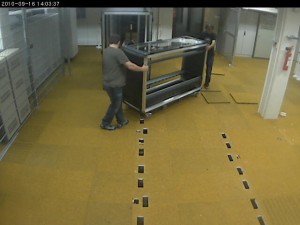
Anlieferung der Racks. Überall wo jetzt noch Löcher in den Bodenplatten zu sehen sind, werden Racks stehen.
Seit einer Woche Rollen nun schon immer wieder LKWs mit IT-Equipment an; inzwischen dürften es mehr als 60 Paletten mit Rechenknoten, Servern, Festplatten, Netzkomponenten, vielen vielen Kabeln, Racks und Kühleinheiten gewesen sein — so 5-10 Tonnen dürften da schon zusammengekommen sein.
Möglich wurde all dies durch einen Forschungsgroßgeräteantrag, zusätzliche Mittel von einigen Lehrstühlen und auch noch Restmittel aus dem Konjunkturpaket-II (letzteres speziell auch für diverse Bau-/Infrastrukturmaßnahmen), etc. …
Der neue HPC-Rechner wird LiMa heißen
- Das Akronym LiMa entstand zunächst durch die Abkürzung zweier Leuchtturmprojekte aus dem Forschungsgroßgeräteantrag.
- Wikipedia hat für Lima (mit kleinem “M”) auch viele Optionen zu Auswahl:
Angefangen von der Hauptstadt Perus und weiterer Städte weltweit (geographische Angaben sind ja durchaus beliebt zur Benennung von IT-Dingen, vgl. nicht zuletzt Intel/AMD-Prozessoren),
… über die malaysische/indonesische Zahl “fünf” oder die tibetische Bezeichnung für eine aus mindestens fünf verschiedenen Metallen bestehende Legierung zur Herstellung von Statuen und Glocken (wir haben mindestens fünf zentrale Bestandteile: Rechenknoten, Hochgeschwindigkeitsnetzwerk, paralleles Filesystem, Software und Stromversorgung/Kühlung)
… bis hin zum Buchstaben “L” im ICAO-Buchstabieralphabet. - Nachdem der LiMa-Cluster aber etwas größer wird als TinyBlue, verglichen mit großen Clustern (z.B. JuRoPa am JSC/FZ-Jülich) aber noch klein ist, kann LiMa auch für Little Machine stehen. Hieran erkennt man die fränkische Bescheidenheit. Obwohl LiMa zum Zeitpunkt der Inbetriebnahme der leistungsstärkste Rechner (bezogen auf die Peak-Performance und wohl auch die Linpack-Leistung) sein wird und mit seinen 63.8 TFlop/s Peak einen (kleinen) Vorsprung vor dem HLRB-II mit 62.3 TFop/s hat, erscheint “SuperFranke”, “SuperERL” oder gar “SuperFranconianAdvancedCluster” (in Anlehnung an SuperMUC, dem aktuellen Beschaffungsprojekt am LRZ) unpassend und übertrieben …
Mal abwarten, welche Erklärung sich für das Akronym letztendlich durchsetzen wird …
Zurück zu den harten Fakten des LiMa-Clusters
Im Rahmen eines europaweiten Ausschreibungsverfahrens wurde die HPC-Lösung mit dem besten Preis-Leistungsverhältnis bestimmt, wobei das Gesamtbudget vorgegebenem war. Neben der Menge der Hardware spielte dabei insbesondere auch die zugesicherte Leistung für einen typischen Erlanger Applikationsmix eine zentrale Rolle. Neun Firmen haben Ende Mai gültige Angebote abgegeben. Als Gewinner der Ausschreibung und somit Lieferant des LiMa-Clusters ist NEC hervorgegangen (Link zur NEC-PRessemeldung).
Der jetzt installierte Cluster stammt aus der NEC LX-2400 HPC-Cluster-Serie und umfasst:
- 500 Rechenknoten mit jeweils zwei Intel Xeon 5650 Prozessoren (6-Core Westmere 2,66 GHz), 24 GB DDR3 RAM, QDR-Infiniband, ohne lokale Festplatte; jeweils 4 Rechenknoten sind dabei in einem 2U hohen Gehäuse untergebracht (“Twin2”); insgesamt sind es also 6000 (physikalische) Rechenkerne und knapp 12 TB (verteilter) Hauptspeicher
- paralleles Filesystem (NEC LXFS = auf Lustre-Basis) mit 120 TB Nutzkapazität auf rund 180 Festplatten (inkl. RAID6-Parity-Platten und Hot-Spare-Platten) und einer aggregierten Bandbreite von 3 GB/s zur kurzfristigen Ablage von Simulationsdaten
- QDR-Infiniband-Netzwerk mit vollständiger Fat-Tree Topologie ohne Ausdünnungen
- 11 geschlossene Racks mit beigestellten Kühleinheiten (=> Rechenknoten); 3 offene Racks (=> Netzwerkkomponenten, Storage, Login- und Managementserver)
- CentOS 5.5 als Betriebssystem, torque/maui als Batchsystem, …
Aktueller Stand der LiMa-Installation
Die NEC-Mitarbeiter kämpfen derzeit noch fleißig mit dem Verlegen der Kabel (insgesamt knapp 2000 Stück; insbesondere die Infiniband-Kabel sind dabei auch noch unhandlich dick) …
Auch die Kaltwasserverrohrung vom Keller bis hoch in den Rechnerraum im 1. OG ist noch nicht vollständig fertiggestellt.
Die Arbeiten gehen aber grundsätzlich zügig voran. Die erste Inbetriebnahme wird jedoch trotzdem noch ein paar Tage auf sich warten lassen — rechtzeitig vor der Frist für die Einreichung zur nächsten Top500-Liste, die im November veröffentlicht wird, sollte jedoch alles laufen. Nicht dass wir auf den Linpack-Wert besonders scharf sind, aber es schadet sicherlich nicht, wenn Franken mal wieder im vorderen Mittelfeld der Top500 sichtbar ist …
Auf die Frage, wann denn der reguläre Benutzerbetrieb beginnt, gibt es eine sehr einfache FAQ-Antwort: wenn alles fertig ist und stabil läuft. Nicht früher und auch nicht später. Weitere Fragen nach einem Termin erübrigen sich damit hoffentlich.
Komplementäre Ergänzung durch TinyFat
Parallel zu LiMa wurden in einem weiteren gekühlten Rack dicke Knoten für Anwender mit hohem Hauptspeicherbedarf beschafft und durch das RRZE installiert:
- 17 Knoten (HL DL385G7) mit jeweils zwei 8-Core AMD MagnyCours Prozessoren (2,3 GHz), 128 GB Hauptspeicher und ebenfalls QDR-Infiniband
- 1 Knoten (HP DL580G7) mit vier 8-Core Intel Nehalem EX Prozessoren und 512 GB (=0.5 TB) Hauptspeicher
TinyFat — der Ursprung für den Namen dürfte klar sein — geht in den Betrieb, sobald die Kühlung der Knoten sichergestellt ist, d.h. die Kühleinheiten mit Kaltwasser aus der zentralen Kälteversorgung verbunden sind.
Betriebsende für (weitere) Teile des “Cluster32” steht bevor
Bereits im vergangenen Jahr musste der älteste Teil des alten Cluster32 (“Transtec-Cluster”) mit den snode0xx-Knoten für TinyBlue weichen. Nachdem jetzt insbesondere mit LiMa so viel neue Hardware gekommen ist, wird in den nächsten Monaten wohl der nächste Teil des “Cluster32” außer Betrieb genommen werden. Insbesondere die beiden Racks mit den snode1xx-Knoten sind nach über 5 Jahren Betrieb nicht mehr wirklich auf der Höhe der Zeit, obwohl die Knoten durchaus noch immer gut ausgelastet sind. Neun (seit der letzten Abschaltung evtl. auch ein paar mehr) der ursprünglich einmal 64 Knoten mit je zwei “Nocona”-CPUs (d.h. der ersten Generation von Intel NetBurst-Prozessoren mit “EM64T”) sind aufgrund von Hardwaredefekten sowieso bereits aus …
2009 ist also die 32-bit Ära bei uns mit der Abschaltung der snode0xx-Knoten zu Ende gegangen, 2010 wird mit der Abschaltung der snode1xx-Knoten dann auch noch die Single-Core-Ära für HPC@RRZE beendet werden. Willkommen im reinen Multi-/ManyCore-Zeitalter
Details zur Abschaltung werden aber noch rechtzeitig folgen.
slight change of the Intel compiler modules: MKL modules loaded automatically
Starting from today, our intel64 compiler modules for version 11.0 and 11.1 of the Intel compilers will automatically load the MKL module corresponding to the bundled version in the Intel Processional Compilers, too.
- If you do not use MKL, this change will not affect you.
- If you want (or have) to use a different version of MKL, you have to load the MKL module before loading the compiler module OR you have to unload the automatically loaded MKL module before loading your desired version.
Motivation for this change was to make the compiler option -mkl work properly (or at least better), i.e. give the user a reasonable chance to find the MKL libraries at runtime. You still have to load the compiler (or mkl) module at runtime OR you have to add -Wl,-rpath,$MKLPATH explicitly to your linker arguments …
Zuwachs im TinyGPU-Cluster
TinyGPU hat Zuwachs bekommen: tg010. Die Hardware-Ausstattung und aktuell auch die Software dieses “Fermi-Knotens” sind anders als bei den restlichen acht Knoten:
- Ubuntu 10.04 LTS (statt 8.04 LTS) als Betriebssystem.
Hinweis: Um lokal auf tg010 mit Intel Compilern <= 11.1 übersetzen zu können, muss [derzeit] das gcc/3.3.6 Modul geladen werden, da sonst libstdc++.so.5 nicht gefunden wird, da diese Bibliothek in Ununtu 10.04 nicht mehr enthalten ist. Das gcc/3.3.6-Modul wird nur zum Übersetzen benötigt – fertige Intel-Binaries laufen auch ohne problemlos. - Die Nvidia-Treiberversion ist inzwischen auf allen Knoten identisch; aktuell: 256.40 / seit 8. Sept. 2010 überall 256.53
/home/hpcund/home/vaultsind (nur) per NFS gemountet (und nativ via GPFS-Cross-Cluster-Mount)- Dual-Socket-System mit Intel Westmere X5650 (2.66 GHz) Prozessoren mit 6 physikalischen Kernen pro Socket (statt Dual-Socket-System mit Intel Nehalem X5550 (2.66 GHz) mit 4 physikalischen Kernen pro Socket)
- 48 GB DDR3 RAM (statt 24 GB DDR3 RAM)
- 1x NVidia Tesla C2050 (“Fermi” mit 3 GB GDDR5 mit ECC)
- 1x NVidia GTX 280 (Consumer-Karte mit 1 GB RAM – war früher im Testcluster)
- 2 weitere PCIe2.0 16x Slots werden in Q4 wohl noch mit NVidia C2070 Karten (“Fermi” mit 6 GB GDDR5 mit ECC) bestückt werden
- statt 2x NVidia Tesla M1060 (“Tesla” mit 4 GB RAM) wie in den restlichen TinyGPU-Knoten
- SuperServer 7046GT-TRF / X8DTG-QF mit Dual Intel 5520 (Tylersburg) Chipset statt SuperServer 6016GT-TF-TM2 / X8DTG-DF mit einem Intel 5520 (Tylersburg) Chipset
Um den “Fermi-Knoten” anzufordern, müssen Jobs :ppn=24 verwenden (statt :ppn=16) und explizit in die neue TinyGPU-Queue fermi submittiert werden. Das Laufzeitlimit ist wie üblich 24h. Ob ECC auf der Fermi-Karte aktuell ein- oder ausgeschaltet ist, wird beim Jobstart angezeigt.
Blog von Antville auf WordPress umgestellt
Das Blog-System der Uni-Erlangen wurde unlängst von Antville auf WordPress umgestellt. (Vgl. https://blogs.fau.de/webworking/2010/08/24/das-neue-blogsystem/.) Ein paar Nacharbeiten habe ich an älteren Artikeln hier in diesem Blog gemacht; ein paar Links mögen aber noch ins Leere führen und ab und zu mag auch das Layout von Artikeln suboptimal sein. Größere Änderungen an bestehenden Artikeln werde ich aber wohl nicht mehr machen. Dafür ist zu viel Tagesgeschäft …
